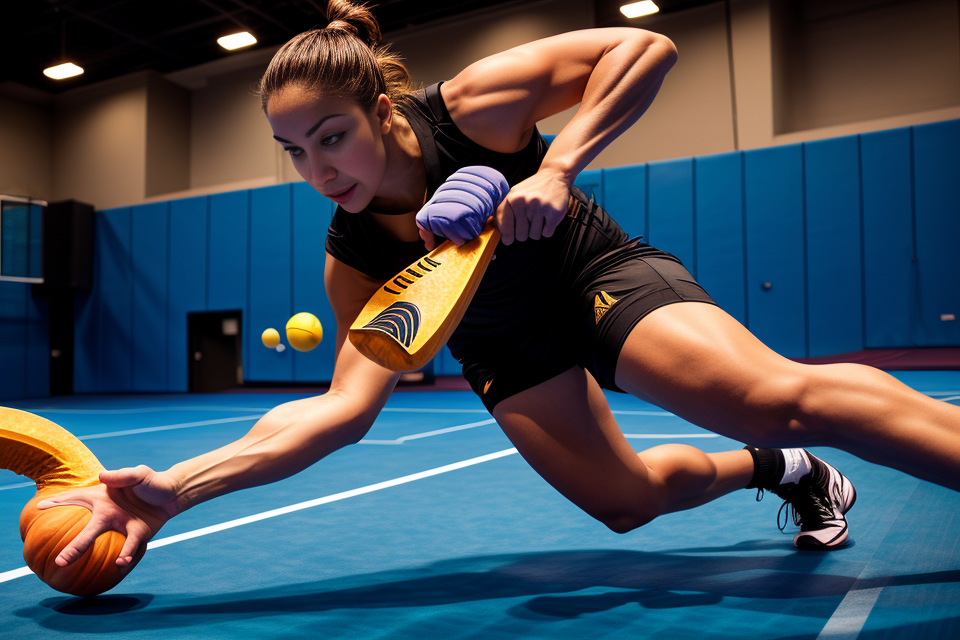Squash is a high-intensity sport that is known for its physical and mental challenges. It is a game that requires agility, strength, and endurance, making it a great way to stay fit and healthy. But what does playing squash do to your body? In this article, we will take a comprehensive look at the physical impact of playing squash and the prevention of injuries. We will explore how the sport can improve your cardiovascular health, increase your muscle strength and flexibility, and help you burn calories. We will also discuss the potential risks and injuries associated with squash and provide tips on how to prevent them. So, whether you are a seasoned player or a beginner, read on to find out how playing squash can benefit your body.
Playing squash can have a number of physical benefits, including improving cardiovascular health, increasing flexibility and mobility, and building strength and endurance. However, it can also put players at risk for certain injuries, such as those to the knees, elbows, and wrists. To prevent injuries, it’s important to properly warm up before playing, stay hydrated, and wear appropriate footwear. Additionally, taking breaks and rest days can help prevent overuse injuries. It’s also important to use proper technique and form when playing, as this can help reduce the risk of injury.
The Physical Demands of Playing Squash
Cardiovascular Fitness
Benefits of Improved Cardiovascular Fitness
Increased Endurance and Stamina
- Engaging in regular squash games can significantly improve cardiovascular endurance, which allows players to sustain physical activities for extended periods without tiring easily.
- As endurance and stamina increase, players can perform at higher intensities, resulting in more efficient movement and better overall performance during matches.
Reduced Risk of Heart Disease
- Cardiovascular fitness plays a crucial role in reducing the risk of heart disease, as it strengthens the heart and improves the circulatory system’s efficiency.
- Regular squash activities can help lower bad cholesterol levels, increase good cholesterol levels, and reduce blood pressure, all of which contribute to a healthier heart.
Improved Overall Health
- Enhanced cardiovascular fitness derived from playing squash has numerous benefits for overall health, including better oxygen transportation to working muscles, improved circulation, and reduced risk of developing various cardiovascular diseases.
- Moreover, increased cardiovascular fitness can contribute to better management of type 2 diabetes, improved sleep quality, and enhanced mental health.
How to Improve Cardiovascular Fitness for Squash
Warm-Up and Stretching Exercises
- Before engaging in any physical activity, including squash, it is essential to warm up and stretch the muscles to prevent injury and enhance performance.
- Dynamic stretching exercises such as lunges, leg swings, and arm circles can help improve flexibility, mobility, and overall readiness for the game.
Interval Training and High-Intensity Exercise
- Incorporating interval training and high-intensity exercises into one’s fitness routine can significantly improve cardiovascular fitness for squash.
- High-intensity interval training (HIIT) and sprint interval training (SIT) are effective methods for improving cardiovascular endurance, anaerobic capacity, and overall athletic performance.
Cardio Drills Specific to Squash
- Specific cardio drills tailored to squash can further enhance cardiovascular fitness and on-court performance.
- Examples of such drills include repeated sprints, shuttle runs, and interval-based exercises that involve alternating between squash-specific movements and rest periods.
Overall, improving cardiovascular fitness through a combination of warm-up and stretching exercises, interval training, and squash-specific drills can lead to increased endurance, reduced risk of heart disease, and improved overall health for squash players.
Strength and Power
Benefits of Strength and Power Training
- Improved Performance on the Court
- Increased speed and agility
- Enhanced ability to hit with power and accuracy
- Reduced Risk of Injury
- Stronger muscles can help prevent injuries caused by sudden movements or changes in direction
- Increased Functional Strength
- Improved ability to perform squash-specific movements such as jumping, lunging, and swinging a racket
How to Build Strength and Power for Squash
- Resistance Training Exercises
- Squats, deadlifts, lunges, and bench presses can help build overall strength and power
- Plyometric Drills
- Jumping exercises such as box jumps and plyometric lunges can help improve power and explosiveness
- Bodyweight Exercises for Squash-Specific Strength
- Exercises such as plank variations, push-ups, and side planks can help target the muscles used in squash and improve core stability and balance.
Flexibility and Mobility
Benefits of Improved Flexibility and Mobility
- Reduced Risk of Injury: Improved flexibility and mobility can help reduce the risk of injury by allowing for greater range of motion and more efficient movement patterns.
- Increased Range of Motion: Greater flexibility and mobility can lead to an increased range of motion, which can help players perform at their best by allowing them to reach for shots that may otherwise be out of reach.
- Improved Balance and Coordination: Improved flexibility and mobility can also lead to improved balance and coordination, which can help players maintain their footing and control their movements on the court.
How to Improve Flexibility and Mobility for Squash
Stretching and Flexibility Exercises
- Dynamic stretching: This type of stretching involves moving in and out of movements to increase blood flow and warm up the muscles before playing.
- Foam rolling: This technique involves using a foam roller to massage and release tension in the muscles, which can help improve flexibility and reduce the risk of injury.
- Yoga: Yoga can be a great way to improve flexibility and mobility, as it focuses on stretching and strengthening the muscles in a controlled and safe manner.
Mobility Drills Specific to Squash
- Lunges: Lunges can help improve mobility and balance by working the hips, legs, and core muscles.
- Squat jumps: Squat jumps can help improve power and explosiveness in the legs, which can be beneficial for moving quickly around the court.
- Agility drills: Agility drills, such as shuffle drills and ladder drills, can help improve coordination and footwork, which can be crucial for success in squash.
Nutrition and Hydration
Importance of Proper Nutrition and Hydration for Squash Performance
Squash is a high-intensity sport that requires excellent physical fitness, technical skills, and mental focus. To perform at your best on the squash court, it is essential to maintain proper nutrition and hydration before, during, and after matches. A well-nourished and hydrated body can help prevent injuries, improve performance, and reduce recovery time.
Macronutrient Needs for Optimal Performance
Macronutrients are the nutrients that the body needs in large amounts for energy and growth. Carbohydrates, proteins, and fats are the three primary macronutrients. Carbohydrates are the body’s primary source of energy, while proteins are essential for building and repairing muscles. Fats are necessary for maintaining healthy skin, hair, and nails.
A balanced diet that includes adequate amounts of carbohydrates, proteins, and fats can help improve your performance on the squash court. Eating a variety of foods, including whole grains, fruits, vegetables, lean proteins, and healthy fats, can ensure that you get all the necessary nutrients for optimal performance.
Hydration Strategies for Squash Matches
Staying hydrated is crucial during squash matches, as dehydration can lead to fatigue, dizziness, and cramps. It is recommended to drink water or sports drinks that contain electrolytes before, during, and after matches. Drinking water regularly throughout the day can help prevent dehydration, while sports drinks can provide additional electrolytes and energy.
It is also essential to monitor your urine color to ensure adequate hydration. Dark urine indicates dehydration, while clear urine indicates proper hydration. If you are unsure whether you are hydrated enough, consider weighing yourself before and after matches to monitor any changes in body weight.
Pre- and Post-Match Nutrition Tips
Pre-match nutrition should focus on providing energy and preventing low blood sugar. Consuming a meal or snack that includes carbohydrates and protein two to three hours before the match can help maintain energy levels. Good pre-match snacks include fruit, crackers, or a sandwich.
After the match, it is essential to refuel and rehydrate to promote recovery. Consuming a meal or snack that includes carbohydrates and protein within 30 minutes of the match can help replenish energy stores and repair muscles. Good post-match snacks include fruit, yogurt, or a protein bar.
In conclusion, proper nutrition and hydration are crucial for optimal squash performance and injury prevention. Eating a balanced diet that includes adequate amounts of carbohydrates, proteins, and fats, staying hydrated during matches, and refueling after matches can help improve your performance on the squash court and prevent injuries.
Preventing Injuries in Squash
Common Squash Injuries
Overuse Injuries
Overuse injuries occur when repetitive movements or overexertion lead to strain or damage to muscles, tendons, or other soft tissues. Squash, with its quick direction changes and jumping, can result in several overuse injuries.
Tennis Elbow
Tennis elbow, also known as lateral epicondylitis, is a common overuse injury affecting the forearm and outer elbow. It occurs when the muscles and tendons that attach to the elbow become strained, leading to pain and inflammation. In squash, tennis elbow can result from repetitive backhand motions or from gripping the racquet too tightly.
Plantar Fasciitis
Plantar fasciitis is an inflammation of the plantar fascia, a thick band of tissue that runs along the bottom of the foot. This condition is often caused by repetitive impact, such as running or playing sports on hard surfaces. In squash, the constant movement and change of direction can contribute to the development of plantar fasciitis.
Rotator Cuff Tendinitis
Rotator cuff tendinitis is an inflammation of the tendons that connect the muscles of the rotator cuff to the bone. This injury commonly occurs in sports that involve repetitive overhead motions, such as squash. The frequent hitting and serving motions in squash can lead to rotator cuff tendinitis.
Acute Injuries
Acute injuries are those that occur suddenly or due to a single traumatic event. They can range from mild sprains to severe fractures.
Ankle Sprains
Ankle sprains are a common injury in squash, especially when changing direction rapidly or landing from a jump. They occur when the ligaments surrounding the ankle joint become stretched or torn.
Hamstring Strains
Hamstring strains involve the overstretching or tearing of the muscles in the back of the thigh. These injuries can happen when sudden changes of direction or jumping cause the hamstrings to work beyond their capacity.
Concussions
Concussions are a type of traumatic brain injury that can result from a blow to the head or a violent collision. In squash, concussions can occur from accidental head collisions with the wall or court floor, or from being hit by a stray ball.
Injury Prevention Strategies
Warm-Up and Stretching
Proper warm-up and stretching are essential components of injury prevention in squash. There are several types of stretching that can be incorporated into a pre-match or pre-practice routine to prepare the body for physical activity.
Dynamic Stretching
Dynamic stretching involves moving stretches that gradually increase the range of motion and intensity of the activity. This type of stretching is ideal for preparing the body for the dynamic and explosive movements required in squash. Examples of dynamic stretches include leg swings, arm circles, and lunges.
PNF Stretching
PNF stretching, or proprioceptive neuromuscular facilitation, is a type of stretching that involves contractions of the muscle followed by a relaxation phase. This method can be more effective in increasing flexibility and reducing the risk of injury compared to static stretching. Examples of PNF stretches include hamstring and calf stretches.
Active Isolated Stretching
Active isolated stretching involves holding a stretch for 8-10 seconds while contracting the opposing muscle group. This method can be particularly effective in improving flexibility and reducing the risk of injury in squash. Examples of active isolated stretches include toe touches and standing quad stretches.
Proper Equipment and Footwear
Choosing the right equipment and footwear is crucial in preventing injuries in squash. Selecting the appropriate racket and grip can help reduce the risk of wrist and elbow injuries, while proper footwear can help prevent ankle and foot injuries. It is important to maintain equipment to ensure optimal performance and reduce the risk of injury.
Developing Good Technique
Developing good technique is essential in preventing injuries in squash. Squash-specific technique drills can help improve the mechanics of the game and reduce the risk of injury. Proper footwork and movement patterns are critical in preventing injuries, and consistency and repetition are key in developing good technique.
Recovery and Long-Term Health
Importance of Recovery for Squash Performance
Active Recovery
Active recovery is a crucial aspect of any exercise routine, especially for squash players. Active recovery involves light cardio and stretching exercises that help to flush out lactic acid and reduce muscle soreness.
Light Cardio and Stretching
After a game of squash, it is important to engage in light cardio activities such as jogging or cycling to increase blood flow and reduce the risk of injury. Additionally, static stretching exercises can help to improve flexibility and prevent muscle stiffness.
Foam Rolling and Self-Myofascial Release
Foam rolling is a popular technique used by athletes to release tension in the muscles and improve mobility. This self-massage technique involves using a foam roller to apply pressure to tight areas of the body, which can help to relieve muscle soreness and improve circulation.
Yoga and Meditation
Yoga and meditation can also be effective active recovery techniques for squash players. These practices can help to reduce stress and anxiety, improve focus and concentration, and promote relaxation and recovery.
Passive Recovery
Passive recovery is another important aspect of recovery for squash players. Passive recovery involves rest and sleep, as well as proper nutrition to aid in recovery.
Rest and Sleep
Rest and sleep are essential for recovery after a game of squash. Adequate sleep allows the body to repair and rebuild muscle tissue, improve immune function, and reduce stress and anxiety.
Nutrition for Recovery
Proper nutrition is also important for recovery after a game of squash. Consuming a balanced diet that includes plenty of protein, carbohydrates, and healthy fats can help to replenish energy stores and support muscle repair and growth.
Long-Term Health and Squash Performance
In addition to recovery, it is important for squash players to prioritize their long-term health and well-being. This includes managing stress and anxiety, prioritizing mental health, and maintaining a balanced lifestyle.
Managing Stress and Anxiety
Squash can be a high-pressure sport, and managing stress and anxiety is essential for optimal performance and long-term health. Techniques such as deep breathing, mindfulness, and cognitive-behavioral therapy can be helpful in reducing stress and anxiety levels.
Prioritizing Mental Health
Mental health is just as important as physical health, and prioritizing mental health is crucial for squash players. This includes seeking support from a mental health professional if needed, practicing self-care, and finding healthy ways to cope with stress and anxiety.
Maintaining a Balanced Lifestyle
Finally, maintaining a balanced lifestyle is essential for long-term health and squash performance. This includes finding a healthy balance between exercise, rest, and leisure activities, as well as prioritizing self-care and self-compassion.
FAQs
1. What are the physical benefits of playing squash?
Playing squash provides numerous physical benefits, including improved cardiovascular fitness, increased muscle strength and endurance, and enhanced flexibility and agility. Squash is a high-intensity sport that requires quick movements and changes of direction, making it an excellent workout for your legs, core, and upper body. Additionally, playing squash can help improve hand-eye coordination and reaction time, making it a great sport for overall physical fitness.
2. How does playing squash impact your risk of injury?
While playing squash can be a great workout, it also carries a risk of injury. Common injuries in squash include sprains, strains, and muscle tears, particularly in the legs and lower back. To reduce your risk of injury, it’s important to warm up properly before playing, stretch after playing, and maintain good technique and form throughout the game. Additionally, investing in proper squash gear, such as shoes with good support and cushioning, can help prevent injuries.
3. Can playing squash help with weight loss?
Yes, playing squash can be an effective way to burn calories and lose weight. Squash is a high-intensity sport that requires a lot of movement, making it an excellent workout for burning calories and fat. Additionally, playing squash can help build muscle mass, which can increase your metabolism and make it easier to burn calories at rest. However, it’s important to remember that weight loss ultimately depends on a combination of diet and exercise, so it’s important to maintain a healthy diet in addition to playing squash.
4. What are some tips for preventing injuries while playing squash?
To prevent injuries while playing squash, it’s important to maintain good technique and form throughout the game. This includes proper footwork, maintaining good posture, and using proper equipment, such as a racquet with the correct grip size and a racquet bag to protect your equipment. Additionally, it’s important to warm up properly before playing and stretch after playing to prevent muscle soreness and injury. Finally, listening to your body and taking breaks when needed can help prevent overuse injuries and keep you healthy throughout the season.










